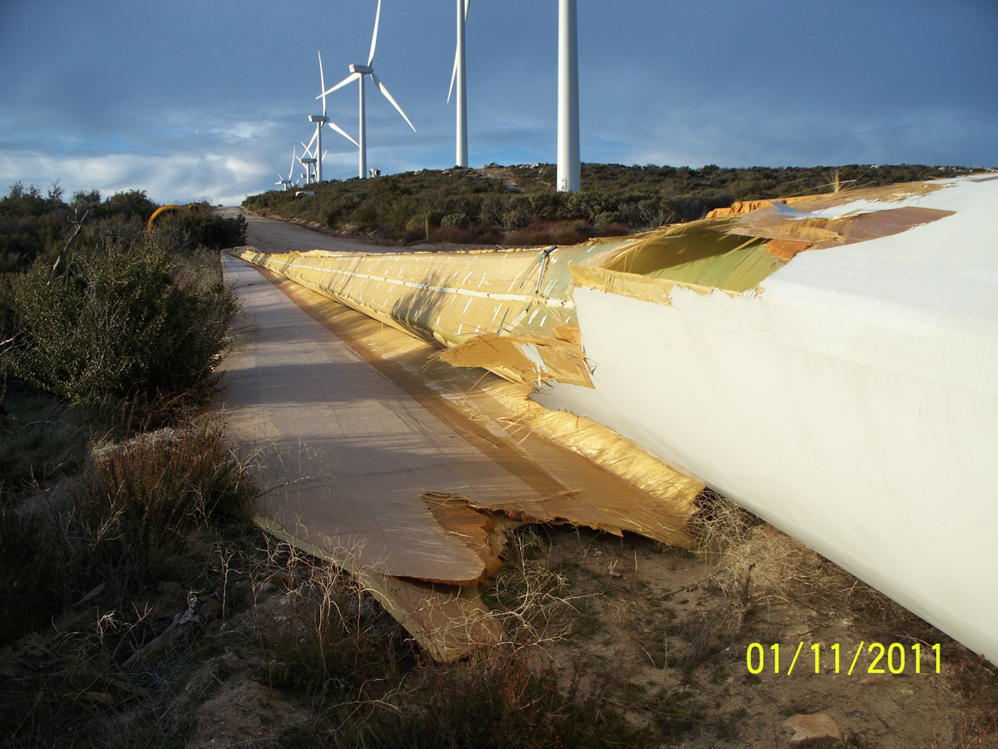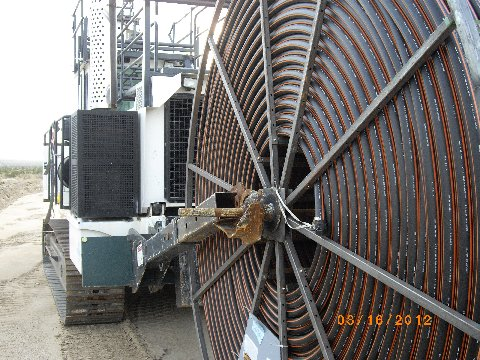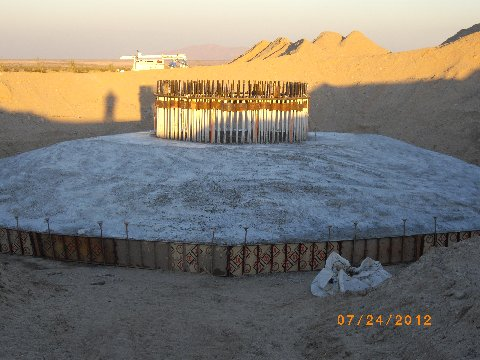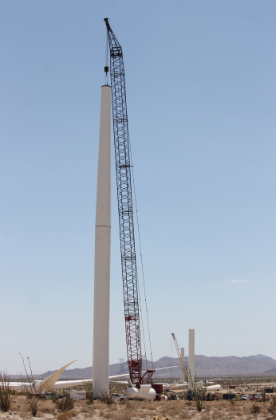| Wind Watch is a registered educational charity, founded in 2005. |
SDG&E receives legal notice of “dangerous conditions” at Ocotillo Express wind project
Credit: By Miriam Raftery | East County Magazine | eastcountymagazine.org 28 August 2012 ~~
Translate: FROM English | TO English
Translate: FROM English | TO English

August 28, 2012 (Ocotillo) — An attorney representing homeowners in Ocotillo has sent a “notice of dangerous conditions of public property” to San Diego Gas & Electric (SDG&E). The letter alleges that at the Ocotillo Express wind project, Pattern Energy is in the process of burying over 80 miles of electrical lines “without the use of any conduit or casement to prevent electrocution.”
Photos taken by ECM photographers indicate lines are only 18-20 inches deep — far shallower than the 48 inches required by the project Environmental Impact Report. In addition, the letter alleges that turbine foundations are too shallow, that massive grading has caused flooding, and that these designs were done without licensed engineers signing off on key project components.

Pattern Energy built the Kumeyaay Wind facility at Campo, where stray voltage/ground current 1,000 times higher than normal has been measured inside a nearby church, tribal hall and homes. The measurements were taken by a medical doctor, an epidemiologist who has published over 100 articles in peer-reviewed journals.
Sixty members of the Manzanita Indian tribe are suffering serious health problems including cancer. Those who are ill have been accepted into a University of California, San Marcos study to confirm if stray voltage is the cause.
Pattern’s Campo facility also blew apart in a storm, after a witness reported an electrical flash that radiated through the wind project. All turbine blades were replaced, but debris still litters the site.
Did Pattern Energy endanger the lives and health of people near the Campo facility with unsafe wiring — and is history repeating itself in Ocotillo?
Pattern has repeatedly refused to discuss problems with its project with ECM or with ECM news partner, 10 News.
ECM has forwarded the attorney’s complaint to the California Public Utilities Commission today, along with additional documentation.ECM has requested an urgent response to these serious apparent violations.A call from a CPUC media representative this morning confirmed that the information was received.
“It is a dangerous condition to employ a direct burial method in an open-space designated ‘multiple use,’ states the letter from attorney William C. Pate with Stuz, Artiano, Shinoff & Holtz in San Diego sesnt to C. Larry Davis at SDG&E.Copies were sent to other SDG&E executives and to Imperial Valley Supervisors.

Robert E. Randall, an electrical engineer in La Mesa, confirmed to ECM that it is illegal to bury 35kV wiring so shallow and that both state and federal laws require "a minimum of 36 inches coverage for this voltage and also a requirement for an indication ribbon 12 inches above the cables."
Engineer Jim Pelley, who has been photographing the construction, said that indication ribbon is "put in the ground along with all the cables all in one shot; I don’t believe there is anything keeping it 12 inches from the cables."
Visitors frequent the recreation area on foot, as well as in vehicles, and the site is susceptible to natural disasters. Hence the project EIR required even deeper standards of 48 inches below ground.
“This is also an active seismic area comprised of sand washes in a 100-year flood zone,” Pate noted. “The soils at these inverse levels are classified as loose, uncohesive sand and highly susceptible to erosion.” ECM has previously raised serious questions about the seismic dangers and lack of evidence provided by Pattern to assure seismic safety.
Over the weekend, more than 200 quakes struck the area, as strong as 5.5 on the Richter scale.Faults running below and very near the site are capable of a 7.5 quake, according to the U.S. Geological Survey, with a high likelihood of a major quake striking the area in the next 50 years.
Pate contends that professional underground practices should have been followed: encasing conduit in concrete to prevent exposure to live electricity.The lines also cross public roads at just 18 inches below grade, he contends.Moreover, development plans submitted were never stamped by an electrical engineer, Pate noted.

Shallow foundations, or an “inverse tee” design, also pose danger to the public, according to Pate who suggests the design could lead to turbine collapse n a flood and earthquake zone. “The developer has not produced foundation designs stamped by a structural engineer, or identified a structural engineer of record,” he observes.
The concrete foundation, a hexagon shape, measures just two feet deep at the outer edge and eight feet deep in the center. By contrast, power poles at SDG&E’s substation are anchored 24 feet into the ground, he notes.The turbines are much taller-up to 439 feet tall — and they will be top heavy with blades, rotor and housing weighing over 140 tons and blade spans the diameters of football fields.

Pattern has failed to produce stamped plans to show that the foundation was designed by a California licensed structural engineer to meet high winds and withstand floods and earthquakes to which this region, which also sits on a federally-designated flood plane, is susceptible.
According to Pate, Pattern has also not provided any evidence that a licensed civil engineer designed 40 miles of new access roads and 81 miles of underground work to assure proper drainage in an area known for flash flooding.About 10 miles of roads have been built thus far and changes to natural drainage results in flooding through the streets of Ocotillo.
“Grading plans were not prepared or submitted as required because, according to a declaration Pattern filed in Federal Court, ‘wind farms require very little actual grading,’” Pate stated.
His letter concludes with a slam against the fast-tracking process, Pattern Energy’s failure to provide proof of engineering to protect public safety, and the apparent lack of oversight on the project overall.
“The pattern here is dangerous property conditions from the absence of engineering and professional design on a project that was accelerated by a full calendar year,” concluded Pate, who has previously filed a lawsuit on behalf of residents over additional serious issues.
This article is the work of the source indicated. Any opinions expressed in it are not necessarily those of National Wind Watch.
The copyright of this article resides with the author or publisher indicated. As part of its noncommercial educational effort to present the environmental, social, scientific, and economic issues of large-scale wind power development to a global audience seeking such information, National Wind Watch endeavors to observe “fair use” as provided for in section 107 of U.S. Copyright Law and similar “fair dealing” provisions of the copyright laws of other nations. Send requests to excerpt, general inquiries, and comments via e-mail.
| Wind Watch relies entirely on User Funding |
 (via Paypal) |
 (via Stripe) |
Share:
| Tag: Complaints |

